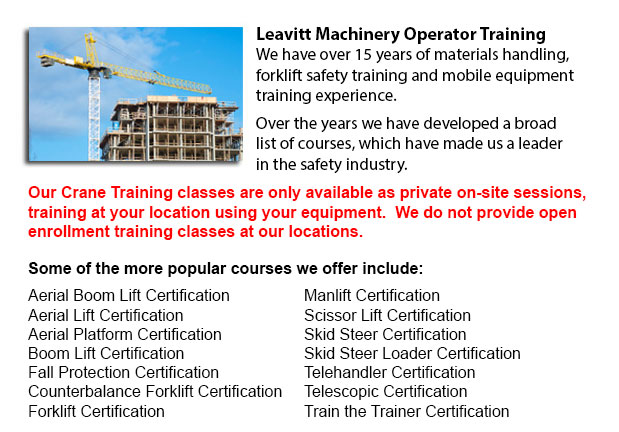
Kingston Overhead Crane Safety Training - Overhead crane safety training equips operators with knowledge and skills regarding crane safety measures, accident avoidance, materials handling, and machine and stock protection. Trainees will learn the kinds of overhead cranes, their capabilities and their uses in different industry environments. For operators who are trained and licensed, the shift in liability moves from the company to the operator. Therefore, the course emphasizes individual operator duties.
Overhead crane safety training instructs operators in the proper techniques for carrying out inspections. Two kinds of pre-shift inspection are the in-depth inspection and the walk-around inspection. These are important daily routines which should be logged. Correctly recorded pre-shift inspections help to protect the business from liability in the event of an accident. Pre-shift inspections also prevent damage, costly repairs and accidents. Operators learn how to designate a particular individual to perform inspections, how to maintain the log book and how to report problems.
Checks should be done frequently and documented correctly. The following must checked while watching for usual problems: hooks for cracks, increases in the throat opening, degree of twist; hoist ropes for corrosion, worn wires, loss of diameter, kinks and bird caging, broken wires, chains for nicks and gouges, heat and chemical damage, cracks and corrosion, twists, excessive wear, distortion, pits, stretching, damage caused by extreme heat.
Operators learn correct rigging procedures in this program. Rigging includes understanding the manufacturer's data plate, determining the material weight to be lifted, choosing the gear, and using safe practices to secure the load. The course cover in detail the following: safe working loads, and the capacities of chains, ropes, hooks, shackles and slings.
It is important to understand who may use the cranes at your facility, the job's physical requirements, and operator qualifications needed for permits and specialized job. Safety should be prioritized when utilizing in the vicinity of pedestrian traffic.
The responsibilities involved in the safe crane utilization consists of checking for hydraulic leaks, undertaking visual inspections, testing the controls, checking the safety guards, examining the hook and hoist rope, braking mechanisms and limit switches. Right reporting methods are vital. These subject matters are all covered in depth in the program.
Correct lifting and moving procedures with hoists and cranes are covered in the program. Operators will become skilled in hand signals. Training includes how to attach the load, raise the load, set the load, unhook the slings and abort a lift.
Moving the load involves a number of steps: starting and stopping procedures, guiding and controlling the load, observing working conditions and working with signals. Operators should know how to proceed in case of a power failure. The course covers methods for lowering the load and removing the slings, parking the crane, storage equipment, and securing an indoor and outdoor crane.
-
Narrow Aisle Forklift / Order Picker Training / Electric Pallet Jack / Electric Pallet Truck Training in Kingston
A pallet lift is a piece of equipment dedicated in the moving of pallets of various dimensions and weights. They might be utilized as an accessory for forklifts, cranes and other styles of heavy machinery or be applied on their own. Pallet lifts are... More -
Kingston Forklift Training School
Kingston Forklift Training School - Forklift Training School - Industry and federal regulators have established the criteria for forklift safety training based on their existing regulations and standards. People wishing to operate a forklift must fin... More -
Kingston Scissor Lift Certification
Kingston Scissor Lift Certification - Scissor lift platforms are utilized at work locations to enable tradespeople - such as iron workers, welders and masons - to reach their work. Making use of a scissor lift platform is usually secondary to their t... More -
Kingston Boom Lift Safety Training
Kingston Boom Lift Safey Training - Boom lifts are a type of elevated work platform or aerial lifting device that are normally utilized in warehousing, construction and industry. Boom lifts could be made use of in practically whichever environment du... More -
Kingston Fall Protection Ticket
Kingston Fall Protection Ticket - Fall-related incidents are the number one reason of death in the construction business. The possibility for fall accidents very much increases based upon the type of work which is being accomplished within your workp... More -
Telehandler Training in Kingston
Telescopic handlers normally called telehandlers for short, are an extremely popular piece of heavy construction machinery. They are widely utilized in the construction and agricultural trades. These machines have farthest reaching ability and are ab... More -
Kingston Warehouse Forklift Training Programs
Kingston Warehouse Forklift Training Programs - Warehouses could either be retail, industrial or commercial facilities, functioning from bulk product retailing to product distribution services. Regardless of the type of warehouse, personnel inside wa... More -
Kingston Heavy Equipment Ticket
Kingston Heavy Equipment Ticket - Depending on the nature of the job at hand, the kind of construction machinery that a heavy equipment operator utilizes varies. Every type of equipment is built to do particular jobs in the most effective method comm... More

Forklift Certification Kingston
TOLL FREE: 1-888-254-6157
Kingston, Ontario
forkliftcertificationkingston.com
Email Us
About Us


